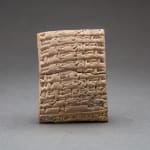Sumerian Cuneiform Tablet, 2030 BCE
Terracotta
2 x 2.75
LSO.600
Sumerian cuneiform is one of the earliest known forms of written expression. First appearing in the 4th millennium BC in what is now Iraq, it was dubbed cuneiform (‘wedge-shaped’) because...
Sumerian cuneiform is one of the earliest known forms of written expression. First appearing in the 4th millennium BC in what is now Iraq, it was dubbed cuneiform (‘wedge-shaped’) because of the distinctive wedge form of the letters, created by pressing a reed stylus into wet clay. Early Sumerian writings were essentially pictograms, which became simplified in the early and mid 3rd millennium BC to a series of strokes, along with a commensurate reduction in the number of discrete signs used (from c.1500 to 600). The script system had a very long life, and was used by the Sumerians as well as numerous later groups – notably the Assyrians, Elamites, Akkadians and Hittites – for around three thousand years. Certain signs and phonetic standards live on in modern languages of the Middle and Far East, but the writing system is essentially extinct. It was therefore cause for great excitement when the ‘code’ of ancient cuneiform was cracked by a group of English, French and German Assyriologists and philologists in the mid 19th century AD. This opened up a vital source of information about these ancient groups that could not have been obtained in any other way. Cuneiform was used on monuments dedicated to heroic – and usually royal – individuals, but perhaps it’s most important function was that of record keeping. The palace-based society at Ur and other large urban centres was accompanied by a remarkably complex and multifaceted bureaucracy, which was run by professional administrators and a priestly class, all of whom were answerable to central court control. Most of what we know about the way the culture was run and administered comes from cuneiform tablets, which record the everyday running of the temple and palace complexes in minute detail, as in the present case. The Barakat Gallery has secured the services of Professor Lambert (University of Birmingham), a renowned expert in decipherment and translation of cuneiform, to examine and process the information on these tablets. His analysis is presented below. Clay Tablet (68 x 50 mm) with 20 lines of Sumerian Cuneifor This tablet is joined from two pieces, but is fully preserved and is written in a large, clear scribal hand. It is an administrative document from the period of the Third Dynasty of Ur, dated to the second year of Ibbi-Sin, last king of the dynasty, c. 2027 BC. It is a list of cattle carcasses and donkey carcasses handed over to the senior manager of a big estate, probably a temple estate. Translation: 13 carcasses of mature cow 25 of traction oxe 30 of three-year-old cow 30 of three-year-old oxe 13 of two-year-old cow 24 of two-year-old oxe 43 of one-year-old cow 39 of one-year-old oxe 1* of mature female donkey 10 of male traction donkey 9 of female three-year-old donkey 8 of male three-year-old donkey 13 of female two-year-old donkey 8 of male two-year-old donkey 15 of female one-year-old donkey 21 of male one-year-old donkey From the managers: Adad-rabi senior estate manager receive Year: the high priestess of Inanna of Uruk was chosen by divinatio * NB – or 60 – the same sign! *** The ‘managers’ here are not the herders, but what we might call middle management: men who supervised the actual herders. The estate would be a temple estate (temples were not merely places of worship – though not for ordinary people – but were big economic organisations) and it had a complex bureaucratic structure. Individual men were assigned herds of cattle and were responsible for their wellbeing and procreation, but they were not watched daily. At regular intervals the cattle under them were counted by a manager. Certain losses were possible: by disease or lions (which were wild in Sumer). But such losses had to be accounted for, and the method was to require the handing-in of the carcass as proof. It also served for supplying the temple with hides, bones, possibly meat etc. This document is a kind of stocktaking, once a year, to help in noting if this kind of loss was under control.



